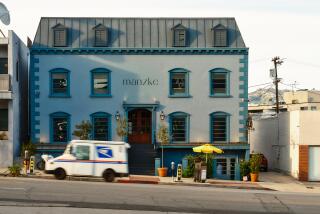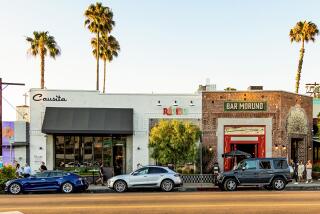Recession takes big bite out of L.A. restaurant business
Stefano Ongaro saw it coming. The owner of the 60-seat Italian restaurant All’Angelo in Hollywood started to notice declining sales last March, and though August had brought an influx of European tourists, by October he was facing another slump. December, typically every restaurant’s busiest month, was even worse.
“I was sitting here one night by myself at 2 a.m. and asked myself, ‘Am I doing something wrong?’ ” Ongaro says. “It was a moment of self-analyzation. And I realized I’m offering diamonds and rubies to a market that can no longer afford it.”
So off came the white tablecloths. The Riedel wineglasses were put away. Menu prices were cut in half. And Ongaro has been scrambling ever since.
Coming off a shaky fourth quarter, restaurants are facing a grim year. Food industry consultant Technomic last month revised its nationwide sales forecast downward. Sales at full-service restaurants in the U.S. are expected to fall 6% in 2009. The picture is worse for fine-dining restaurants; sales are estimated to drop 12% to 15%.
Los Angeles restaurants -- already hit by the Writers Guild of America strike and one of the nation’s steepest housing downturns -- may have it even harder.
Campanile sales were down 15% in 2008, says Jay Perrin, general manager of the landmark restaurant on La Brea Avenue. “In the summer, between the second and third quarters, it was a little lower than normal, and it never came back after that. The scary part is that in the final quarter we were down 25% and December was our worst-grossing month.”
Restaurant chains are consolidating, closing their lowest-performing outlets, and independent restaurateurs have no choice but to tighten their belts and further cut costs (and, to draw customers, their prices), sometimes going to great lengths to do so.
In a dramatic move, Citrus at Social Hollywood announced last month that it would open for only three days a week.
“We made a decision at the end of December and we implemented it,” says Jeffrey Chodorow, an owner of China Grill Management, which operates two restaurants in L.A. -- Asia de Cuba and Citrus. “By November everybody knew that this was going to be hard. . . . People started to cancel events for parties. We had a relatively decent December with events, but not what it would have been.”
Chodorow, who did not provide sales figures, says he has no intention of closing Citrus and plans to expand hours again when the economy recovers. “I have no idea when that is,” he says. “Does anyone? Do you?”
Owner of all trades
In an alley behind All’Angelo, with a cigarette in one hand and a Bluetooth device tucked behind his right ear, Ongaro is arranging birds of paradise in a giant vase set on top of a folding table. “I’ve discovered a femininity I didn’t know I had,” he jokes, adding more leaves to the vase.
Ongaro has just returned from the flower market downtown, where he also stopped at wholesalers to buy fish and vegetables for the restaurant, which opened in January 2007, followed by plenty of good press. Despite also adding delivery service to customers in the area, he has had to cut his staff to eight from 17.
“I get up at the crack of dawn and I go to the markets four times a week,” he says. “I had to figure out how to offer cheaper prices without compromising the quality of the food. People are going to go buy at the market and then bring it to me? OK, I save money by shopping myself. Nothing better than seeing it with your own eyes.”
Ongaro also writes the menus, stocks the wine, manages the invoices and each night takes every order at every table, then handles closing duties and finishes at about 1 a.m. “I have no other life. My wife is what we call in Italy a ‘white widow,’ ” referring to the fact that she rarely sees him.
He’s certainly not the only restaurateur hustling for business, retooling menus to offer more affordable or discounted items. (Witness the popularity of DineLA -- in which participating restaurants offer discounted meals -- and the wave of dinner specials that are rolling out each week, labeled “Economic Stimulus Menu” or “Recession Busters.”)
“It’s all about getting people in the door,” says Eric Greenspan, chef-owner of the Foundry on Melrose.
The results of a survey released this month by marketing research firm Morpace Omnibus show that 48% of U.S. consumers are eating out less often now than they did six months ago. (This compares with just over a third reporting the same thing as of September.)
“There are so many restaurants in L.A., you’re lucky if someone comes in twice a year,” Greenspan says. “Weekday business is hurting the most, but people are still going out on weekends.”
In the hope of attracting a weekday crowd, Greenspan recently converted his main dining room to a lounge, started offering live music every night and relegated his fine-dining menu to the back patio. In the lounge, entrees such as duck confit with romaine and spaetzle or poached chicken with goat cheese polenta are less than $20.
“It’s helped,” he says, “because now we get people who normally wouldn’t come in, people who weren’t looking for a fine-dining experience and who frankly would be offended by the prices.”
It’s the same all over -- to cut prices, restaurateurs have had to find ways to rein in costs. “Every penny counts,” Greenspan says. “It’s what keeps you in business.” He has changed his trash service, bought less expensive paper for menus, shifted staff hours and changed payment schedules. “I make sure the dishwashers run the dishwashing machine only with all the plates in there. There’s all kinds of things you can do. You have to make sure the changes you make don’t affect the customer.”
But as restaurateurs offer deals and discounts, they’re faced with the potential double whammy of fewer customers and lower prices squeezing already thin profit margins. The California Restaurant Assn. estimates that net profit margins average 2% to 5%, according to CRA’s president and chief executive, Jot Condie, and that’s in normal times.
Ongaro claims sales have dropped a stunning 50% from a year ago. “If the moment comes again, I’ll serve foie gras, caviar, lobsters,” he says. For now, there’s pappardelle with lamb ragout for $15 and breaded pork cutlet or Mediterranean striped bass for $20.
Meanwhile, restaurant openings continue. “Believe it or not, there are still opportunities,” Condie says, “especially for restaurants that embrace a new business model catered toward value or meals that don’t necessarily have a heavy price.”
A new boast
It wasn’t so long ago that the $40 entree was sweeping the nation. Restaurants now tout that their menus have nothing over $25, such as the new, casual Italian steakhouse Tonys on Sunset Boulevard, which opened this month (martinis are $5). Or nothing over $14, as at the new restaurant Cabbage Patch in, of all places, Beverly Hills. The owner of Bloom Cafe on Pico Boulevard in Mid-City recently expanded and opened Chic Cafe, offering takeout meals that will feed six to eight people for about $40.
Still, it’s a tough environment in what even in the best circumstances has been a challenging enterprise.
John Self, an associate professor at Collins College of Hospitality Management at Cal Poly Pomona who has published a study of restaurant failures, estimates that 1,100 restaurants open in L.A. County every year. Among those, about 24% close the first year, and about 50%, cumulatively, within three years, according to his study. This economy “could double that first-year rate,” he says.
“When a restaurant closes, most people just say, ‘Oh, it closed,’ but behind that is tragedy; someone has lost a dream, maybe lost relationships with friends and relatives, a lot of people have lost their jobs. It’s no small thing. But when we recover, the businesses that have made it through will be stronger than ever.”
More to Read
Sign up for our L.A. Times Plants newsletter
At the start of each month, get a roundup of upcoming plant-related activities and events in Southern California, along with links to tips and articles you may have missed.
You may occasionally receive promotional content from the Los Angeles Times.







